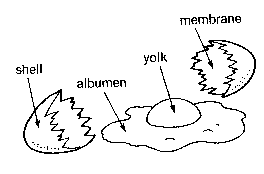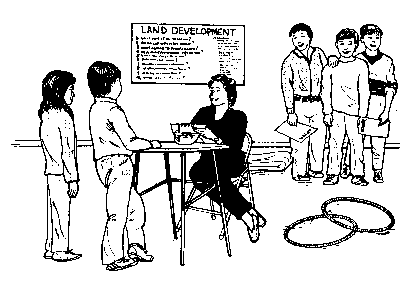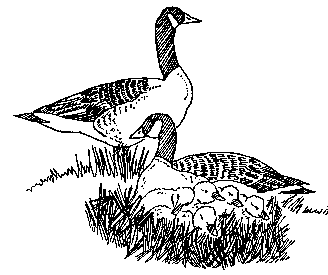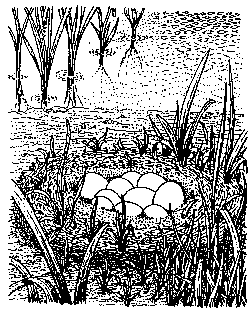Lessons & Units
A database
of lessons and units searchable by content and cultural standards,
cultural region and grade level. More units will be available soon.
You can use Acrobat Reader to look at the PDF version of the Cover
Sheet
for the Units and Self-Assessment
for Cultural Standards in Practice.
BIRDS
Lesson 4 Bird Habits and Habitat
Objectives:
1) Students will be able to list the necessities of good
bird habitat and describe some causes of loss of habitat.
2) For each bird studied students will know
- the particular
habitat of that bird
- the type of food
eaten.
- the type of nest made
and number of eggs laid
3) Students will be able to describe the life cycle of a
bird.
Activities:
1) Brainstorm on what are the necessities in a bird's
life and how it affects where birds live. Why do the different
birds require a different habitat? Then have students recall where
each bird on the local list is most commonly seen. Categorize
birds on your list according to habitat. Use a field guide if
additional information is needed. (Alaska's Birds, "Where
Do Birds Live?" pg. 63-67)
2) Discuss what is meant by "loss of habitat" and how it
affects local birds. What are some of the reasons for loss of bird
habitat? Refer to "Shrinking Habitat" from Teach About
Geese.
3) Research the type of food eaten by each bird using the
following resources: a local elder or community member, personal
observation, a field guide or other written material. How do the
different types of birds get their food? Review types of
beaks.
4) Research the type of nest made by each kind of bird. Take a
field trip to look for bird nests and try to figure out which kind
of bird made each nest found. If there are eggs, their size and
color will help to identify the bird. The location of the nest
will also give you a clue.
5) Brainstorm about how long birds live
and how fast they multiply. Students should estimate and
then calculate
with paper
and pencil. Find out how many eggs a bird lays in a season and
then figure out how many offspring a pair of birds could produce
in a normal lifetime. What factors will affect the number of these
birds that survive to reproduce? Refer to "Don't Put All Your Eggs
in One Basket" from Wildlife for the Future.
6) Discuss the life cycle of a
bird and illustrate it. Refer to the front page of the "White
Fronted Geese" article in the Appendix.
7) Take a close look at an egg: (use a chicken egg!) Break open
an egg so students can see basic egg parts.
a. the shell - the
outside of the egg
b. the membrane - the
cellophane-like material that lines the shell
c. the albumen - the egg
white
d. the yolk - the yellow
center
What is the function of each part?

from TEACH ABOUT GEESE
|

|
UNIT IV-2
Management
and
Planning
SHRINKING
HABITAT
|
|
Grades: 4-7
Subject: application, comparing similarities
and differences, description, discussion,
evaluation, generalization, kinesthetic
development, observation, synthesis
Duration: one 45-minute or period longer
Group Size: minimum of six students, with
one developer, one carnivore, three herbivores, and
one bush
Settings: indoors or outdoors; large area
with room for people and props
Key Vocabulary: habitat, food chain,
development, herbivorous, vegetation,
consequences
Topics: land use, land use planning, people
and wildlife sharing environments, responsible
human actions, habitat for wildlife
|
Objectives:
Students will be able to:
1) Describe some effects of human development of land
areas on plants and animals previously living in the area.
2) Evaluate the importance of suitable habitat for
wildlife.
3) Recognize that loss of habitat is generally considered to be
the most critical problem worldwide facing wildlife today;
and that habitat loss influences Yukon-Kuskokwim Delta geese
populations, especially along the Pacific flyway.
Method
Students simulate some of the potential impacts of land
development on geese and their habitat in a physically active
game.
Background
In Alaska, all over the United States, and throughout the world,
wildlife habitat is being lost. Whenever an area of land is paved for
a shopping center, divided and excavated for homes for people, and
sometimes when it is plowed to grow a crop, animals lose their homes,
and frequently their sources of food and water. Larger animals that
may depend upon smaller animals as a source of food also disappear.
Some animals cannot tolerate human intervention and may disappear
although their food and water sources are not directly affected.
Students may have observed this phenomenon near their communities.
This process is happening in large ecosystems and small, world wide.
For example, many wetlands have been filled and drained to make land
for farming and buildings. When wetlands are filled, many kinds of
life forms, such as geese and other water birds, reptiles,
amphibians, crustaceans, and a wide variety of vegetation, are lost.
Some animals can move to new habitat, most often they can not.
Migrating geese from the Yukon-Kuskokwim Delta depend upon
wetlands for wintering areas in states and countries along the
Pacific Flyway. Over 90 percent of the wetlands in the lower Pacific
Flyway have been destroyed by draining, filling, dredging, and
pollution. Wetlands in Alaska are also vulnerable to development. In
Anchorage, significant numbers of acres of wetlands are lost
annually. Alaska still has wetlands, but they must be protected so
that we keep sources of salmon, moose, and berries close by and the
geese return to nest each spring. (See Facts About Geese for
additional background information about wetlands.)
Materials
Green and blue construction paper, classroom desks, tables or
chairs, five or six large bedsheets or blankets for a student group
of about 25.
Procedure
1. Review with the students the elements necessary for a habitat
(food, water, cover, and space arranged suitably for the particular
animal). If the students have the background, use specific goose
examples in your discussion. After some discussion to make sure that
the elements of habitat are clearly in mind, tell the students that
in this activity they will be simulating wildlife in its habitat.
2. Divide the students into four groups:
herbivores, carnivores, vegetation (shrubs, grasses, etc.),
and people who will be village
planners. If the students are not familiar with the terms "herbivore"
and "carnivore," provide them with working definitions of those terms
(herbivore, a plant-eating animal; carnivore, a meat-eating animal;
and although not needed for this activity, omnivore, an animal that
eats both plants and animals). Plan for three times as many
herbivores as carnivores with a small number of village planners in
proportion to the other two groups. The numbers (amount) of
vegetation may vary. For example, two planners, three carnivores,
nine herbivores, and eleven bushes (vegetation).
3. Establish a large area (either in the
classroom with tables, chairs, and desks moved to the sides
of the room, or outside) that
can be used to simulate the wildlife habitat area before development.
The "village developers" are to stay on the sidelines at this time,
simply observing the undeveloped land and its wildlife inhabitants.
They may be meeting on their own, nearby, to make plans for
development. In fact, they can make their entrance rather suddenly
once the wildlife habitat has been established, simulating the
arrival of heavy construction equipment. This is the situation the
developers are considering: The village has to be moved because the
river is changing and the old site floods every spring. The site
selected by the village was chosen because it is near the water but
had high & dry places for buildings and roads. It was also
selected for its access to wood and to wildlife for hunting and
fishing.
4. Provide each "herbivore" with:
* Two desks or chairs to use as "cover" (or
string or hula hoops).
* Three pieces of green construction paper to represent
food.
* One piece of blue construction paper to represent
water.
* Some of the vegetation (portrayed by students).
Provide each "carnivore" with:
*
One desk or chair to use as a "den" (or string, or hula
hoop).
*
Space equivalent to that used by three herbivores.
*
Three herbivores as a potential food source portrayed
by students.
* One
piece of blue construction paper to represent water.
*
Some of the vegetation (portrayed by students).
5. Ask the "herbivores" to arrange the food, water, and cover;
including the students who are "vegetation" in a space to represent
their habitat. Once the herbivores have arranged their habitat, ask
the "carnivores" to move into the area to establish their lairs and
water sources, keeping an eye on the herbivores as possible food
sources. For added interest, suggest that the students identify what
particular kind of animal they are, and role-play its
characteristics. (This phase takes about ten minutes, with the
developers planning while the herbivores and carnivores arrange their
habitat.)
6. Once all the animals are established in their habitats, it is
time for the developers to enter the picture. These developers have
been given the opportunity to create a new village site. (They may
use three to seven minutes to construct their development, explaining
their actions as they take them.) They are restricted in how much
space they can use. They may use the space equivalent to that used by
three herbivores. The developers may use the sheets and blankets to
build their development. They may remove bushes (represented by
students), cover (represented by desks), food and water.
7. Once they have constructed their village, engage all of the
students in a discussion of what happened. What action took place?
With what consequences? Would or did any animals die? From what
causes? Could the developers have done anything differently to change
the consequences? Could they have developed several scattered small
areas instead of one large area, or vice versa, with what effects?
Would it have reduced negative consequences for wildlife if they put
the development in a different area of the habitat? Rather than
negative consequences, were there positive consequences? If so, what
were they? How were they achieved? Ask the students to consider and
discuss what seemed realistic about the activity, and what did not.
For example, sometimes development can take place that enhances the
area for some kinds of wildlife. Often, however, it will not be the
same kinds of wildlife that were in the area before development.
Planners and developers can sometimes add to the vegetation in an
area, creating additional cover and food for some kinds of wildlife
and make water sources available under some conditions, if there is
insufficient water in the area.
8. Ask the students to summarize some of the possible impacts on
wildlife from human activities like development of land areas. Are
there places in your community where wildlife habitat has been lost
by human development? Are there places where wildlife habitat has
been enhanced by human activity? What alternatives, if any, are there
to development of previously undeveloped areas? What tradeoffs are
involved: for example, in developing vacant areas within communities
rather than undeveloped areas outside communities? If development
does take place, what kinds of actions can people take to minimize
the negative consequences for wildlife, vegetation, and other
elements of the environment? What about possible economic costs?
Social costs? Ecological costs? Aesthetic costs? etc. Discuss loss of
habitat as something that is affecting wildlife all over the planet.
Ask the students to summarize the importance of suitable habitat for
wildlife. Discuss the students' concerns and recommendations.
Extensions
1. Conduct this activity twice, with the students trading roles
the second time. When the former wildlife become developers, they
could see if they could produce a development plan that could benefit
the area for people and wildlife in some ways. The activity can also
be conducted to show differences between developing the entire
area-with likely loss of all wildlife in the area-to developing only
part of the area, with some wildlife likely to survive.
2. Ask students to complete the following
sentence, and discuss their response: "If I were going to
build a house for my family in a previously undeveloped area,
I would"
Evaluation
Name and describe three animals or plants which used to live in
your area, but no longer do. Describe the changes that seem most
responsible for eliminating each of these plants or animals. Suggest
and evaluate the advantages and disadvantages, if any, of possible
actions that could have been taken to prevent the elimination of
these plants or animals from the area. Name one kind of wildlife that
would do better and one kind that would do worse, in areas in which
humans cut down a forest and planted grass; dammed a creek to flood a
valley; put in a housing development with large lawns and many
shrubs; built a city on a lakeshore with crowded skyscrapers.
Adapted from Project WILD

DON'T PUT ALL YOUR EGGS IN ONE
BASKET
|

|
|
Grade Level: K-4
Subjects: Science, math, art, language
arts
Skills: Art skills, counting, comparing,
predicting, drawing conclusions
Duration: Two 30 minute sessions
Group Size: Individual
Setting: Indoors
Vocabulary: Clutch, declining population,
extinct, population, production
|
|
Objectives:
Students will:
1. Learn that animal populations grow through births, and
2. Observe the relationship between the size of a population and
the number of young that are born each year.
Teaching Strategy:
Students simulate a population of nesting geese and analyze the
results of the simulation.
Materials:
Paper cups (one per student), photocopies of Goose Pair
Silhouettes, dry grass, goose down or cotton batting, beans, poster
paper, glue or tape
Background:
This activity introduces young students
to a population of geese as it changes in size through births.
Students will observe the
capacity of small and large populations to grow through births each
year. Older students can use their math skills in the activity "Population Explosions" to
observe this relationship.
A consequence of the birth rate of a population is the ability of
the population to build up from small numbers. As long as a
population is relatively large, animals that die are replaced each
year when young are born and grow up. Wildlife managers are concerned
about small populations of wildlife because they may be in danger of
going extinct. If populations are small or have declined to low
numbers, people may need to make efforts to help the population grow
or recover.
Procedure:
1. Pass out the paper cups and make the grass, down or cotton
batting, and beans available to the students. Tell the students that
they will each be making a goose nest by gluing tile grass and down
or batting in the cup.
2. After the students have made the nests, give each student the
goose illustrations and have them cut out pairs of geese.
3. Tell the students that each pair of geese will produce 5 eggs
each year. Have each student place five beans in their nest.
4. Create a large graph on the poster paper
with two columns. Label the left-hand column "Pairs of Geese" and the right-hand column
"Number of Eggs" (see illustration). Explain that a goose population
will have a certain number of pairs. See the activity "Population
Posters" in this Activity Guide if you have not introduced the term
"population" to your class.
5. Begin filling in the chart.
Start with "one pair of geese." Ask a student to bring up a goose
pair silhouette. The geese can be taped or glued to your chart. Move
to "two pairs of geese." Again ask students to bring the pairs up.
Continue until the population has 20 pairs.
6. Explain to the students that the number
of eggs laid by each pair varies; for the purpose of this
activity, however, each goose
pair will lay five eggs. Begin with "one pair of geese" and draw a
nest (circle) and fill it with five eggs. Ask the class to count the
number of eggs in the egg column and write that number down. Continue
this process for the increasing number of pairs (older students can
do this by multiplication).
7. Compare the number of eggs laid by the largest population with
those of smaller populations. Encourage students to think of things
that could happen to geese so there would be fewer geese in a
population (they could be eaten by predators, harvested by hunters,
die from accidents, or starve to death because there was too little
food, etc.). Which population would recover quickest if each
population lost ten geese? (the smallest population would become
extinct, other small populations would take a long time to recover
because there would be fewer eggs each year compared to the larger
populations. The largest population would recover the quickest.
8. Explain that people are concerned about small populations of
wildlife because they may be in danger of going extinct.
Extensions:
1. On poster paper, have the
class write a story about what they learned. Place the story next to
the graph. Younger students can dictate the story to you as you
write.
2. The activity assumed that all female geese layed the same
number of eggs. Explain to the students that female geese do not
always lay the same number of eggs. Each student should choose the
number of beans to place in their nest. The number should be between
3 and 7. Hide the nests around the room or on the schoolgrounds and
then have the students conduct a nest search and count the total
number of eggs. Older students can calculate the average clutch size
(number of eggs per nest) by adding up the numbers in each nest and
dividing the total by the number of nests.
3. For older students, develop multiplication
problems: "If a pair
of geese produces 5 eggs, a
population of 5 pairs of geese
produces eggs.

Evaluation:
1. have students choose an endangered species and create a skit.
The skit should depict the dangers that face the offspring of both
populations that can recover quickly and those that recover
slowly.
Resources:
Additional teaching activities about arctic nesting goose
populations: Teach About Geese, K-12 curriculum. U.S. Fish and
Wildlife Service. Anchorage, AK. 1988.
Goose Pair Silhouettes
Handbook
for Culturally Responsive Science Curriculum by Sidney Stephens
Excerpt: "The information and insights contained in this document will be
of interest to anyone involved in bringing local knowledge to bear in school
curriculum. Drawing upon the efforts of many people over a period of several
years, Sidney Stephens has managed to distill and synthesize the critical ingredients
for making the teaching of science relevant and meaningful in culturally adaptable
ways." |